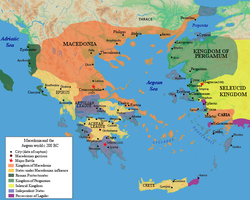This article concerns the period 199 BC – 190 BC.
Year 195 BC was a year of the pre-Julian Roman calendar. At the time it was known as the Year of the Consulship of Flaccus and Cato. The denomination 195 BC for this year has been used since the early medieval period, when the Anno Domini calendar era became the prevalent method in Europe for naming years.
Year 192 BC was a year of the pre-Julian Roman calendar. At the time it was known as the Year of the Consulship of Flamininus and Ahenobarbus. The denomination 192 BC for this year has been used since the early medieval period, when the Anno Domini calendar era became the prevalent method in Europe for naming years.

Philip V was king of the ancient Greek kingdom of Macedon from 221 to 179 BC. Philip's reign was principally marked by the Social War in Greece and a struggle with the emerging power of the Roman Republic. He would lead Macedon against Rome in the First and Second Macedonian Wars. While he lost the latter, Philip later allied with Rome against Antiochus III in the Roman-Seleucid War. He died in 179 BC from illness after efforts to recover the military and economic condition of Macedonia and passed the throne onto his elder son, Perseus of Macedon.
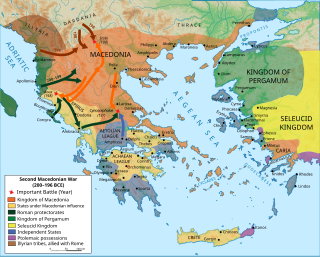
The Second Macedonian War was fought between Macedon, led by Philip V of Macedon, and Rome, allied with Pergamon and Rhodes. Philip was defeated and was forced to abandon all possessions in southern Greece, Thrace and Asia Minor. During their intervention, although the Romans declared the "freedom of the Greeks" against the rule from the Macedonian kingdom, the war marked a significant stage in increasing Roman intervention in the affairs of the eastern Mediterranean, which would eventually lead to Rome's conquest of the entire region.

Nabis was the last king of independent Sparta. He was probably a member of the Heracleidae, and he ruled from 207 BC to 192 BC, during the years of the First and Second Macedonian Wars and the "War against Nabis" named for being against him. After taking the throne by executing two claimants, he began rebuilding Sparta's power. During the Second Macedonian War, Nabis sided with King Philip V of Macedon and in return he received the city of Argos. However, when the war began to turn against the Macedonians, he defected to Rome. After the war, the Romans, urged by the Achaean League, attacked Nabis and defeated him. He then was assassinated in 192 BC by the Aetolian League. He represented the last phase of Sparta's reformist period.
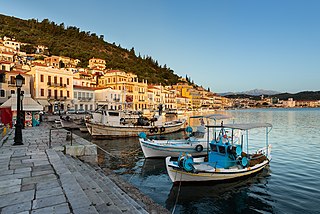
Gytheio or Gythio, also the ancient Gythium or Gytheion, is a town on the eastern shore of the Mani Peninsula, and a former municipality in Laconia, Peloponnese, Greece. Since the 2011 local government reform it is part of the municipality East Mani, of which it is a municipal unit. The municipal unit has an area of 197.313 km2.

Philopoemen was a skilled Greek general and statesman, who was Achaean strategos on eight occasions.
The First Battle of Lamia was fought in 209 BC between the forces of Philip V of Macedon and the Aetolians led by Pyrrhias. The Aetolians were aided by a small Roman force and a force from the kingdom of Pergamon. The Macedonians were victorious. Another battle was fought at Lamia within the year.
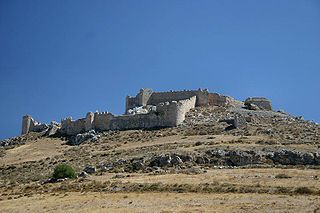
Larisa is the ancient and medieval acropolis of Argos, located on a high rocky hill, within the town's boundaries to the west. According to Strabo, it is named for a group of Pelasgians. The summit is occupied by the ruins of a Byzantine-Venetian castle, below it, roughly midway down the slope of the mountain, is Panagia Katakekrymeni-Portokalousa monastery, and opposite the castle entrance, the Monastery of Agia Marina, a nunnery. The site was fortified and in continuous use for nineteen centuries.
Lucius Quinctius Flamininus was a Roman politician and general who served as consul in 192 BC alongside Gnaeus Domitius Ahenobarbus. He was eventually expelled from the Senate by Cato the Elder.

The Cretan War was fought by King Philip V of Macedon, the Aetolian League, many Cretan cities and Spartan pirates against the forces of Rhodes and later Attalus I of Pergamum, Byzantium, Cyzicus, Athens, and Knossos.
Philoces was Philip V of Macedon's prefect and commander on the island of Euboea. In 200 BC he was ordered by Philip to ravage Attica with 2,000 infantry and 200 cavalry. According to Polybius the ravaging that Philoces gave Attica was the worst since the Persian War. In 197 BC he tried to relieve the city of Eretria but he was driven off by the Roman army besieging the city. He was then put in charge of a group of 1,500 who went to Achaea and relieved Corinth and had Argos surrendered to them. Philioces later gave Argos to Nabis of Sparta in return for a Spartan alliance with Macedon. Philoces still remained commander of the Macedonian garrison at Argos after the exchange and when Nabis deserted the Macedonians and went over to the Romans, Philoces was offered by the Romans to surrender the city to them. Philoces surrendered the city and was allowed free passage to Macedon. This is the last that is heard about Philoces.

The Laconian War of 195 BC was fought between the Greek city-state of Sparta and a coalition composed of Rome, the Achaean League, Pergamum, Rhodes, and Macedon.
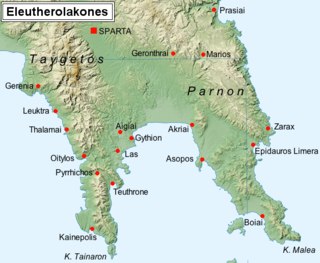
The League of Free Laconians was established in southern Greece in 21 BC by the Emperor Augustus, giving formal structure to a group of cities that had been associated for almost two centuries.
Dexagoridas was the joint Spartan commander of the port of Gythium. During the Roman-Spartan War, the Romans and their allies besieged Gythium. After a few days of fighting, Dexagoridas sent word to a Roman legate saying he was willing to surrender the city. But when the other commander of the garrison, Gorgopas, found out, he slew Dexagoridas with his own hands. The garrison managed to hold out for a few days but when the Roman commander-in-chief, Titus Quinctius Flamininus, arrived with reinforcements, Gorgopas surrendered on the condition that he could return to Sparta, with the garrison unharmed.
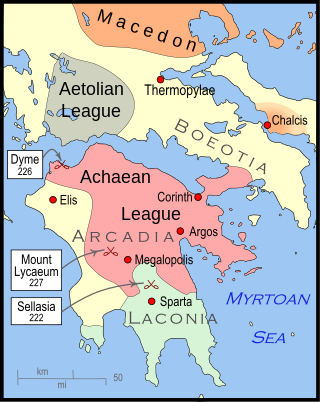
The Cleomenean War was fought between Sparta and the Achaean League for the control of the Peloponnese. Under the leadership of king Cleomenes III, Sparta initially had the upper hand, which forced the Achaean League to call for help the Macedonian king Antigonos Doson, who decisively defeated Cleomenes in the battle of Sellasia in 222.
Gorgopas was one of the joint Spartan garrison commanders at Gythium. During the Roman-Spartan War, the Romans and their allies started besieging Gythium. After a few days of fighting, Gorgopas' joint commander, Dexagoridas, told a Roman legate that he was willing to surrender the city. When Gorgopas found out, he slew Dexagoridas with his own hands. Gorgopas continued to command the city but when the Roman commander-in-chief Titus Quinctius Flaminius arrived with reinforcements, Gorgopas surrendered on the condition that he and the garrison could return to Sparta unharmed. Nothing more is heard of him.
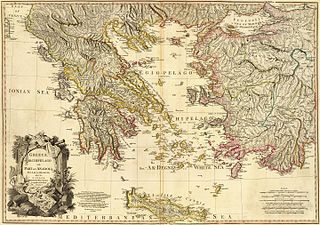
The history of Sparta describes the history of the ancient Doric Greek city-state known as Sparta from its beginning in the legendary period to its incorporation into the Achaean League under the late Roman Republic, as Allied State, in 146 BC, a period of roughly 1000 years. Since the Dorians were not the first to settle the valley of the Eurotas River in the Peloponnesus of Greece, the preceding Mycenaean and Stone Age periods are described as well. Sparta went on to become a district of modern Greece. Brief mention is made of events in the post-classical periods.
Laconicus was a Spartan of royal descent who appears as king of Sparta for a brief moment in the aftermath of the assassination of the tyrant Nabis in 192 BC. Little is known about him; even his name may not be correct.

